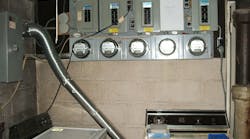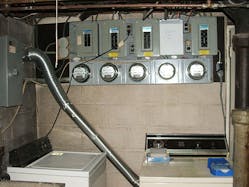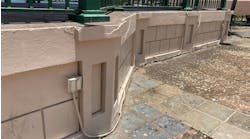How well do you know the Code? Think you can spot violations the original installer either ignored or couldn't identify? Here's your chance to moonlight as an electrical inspector and second-guess someone else's work from the safety of your living room or office. It's your turn to identify the violation.
Hint: A laundry list of problems
Find the Answer
Putting the laundry equipment in front of all of these panelboards was a really bad idea. Not only does this create some Code violations, but it could also create some real problems in the event of an emergency when the power needs to be turned off in a hurry.
Section 240.24(A) requires overcurrent devices to be readily accessible. Since the washer and dryer are sitting right in front of all of these circuit breakers, it becomes very difficult for someone to access these safety devices. Similarly, Sec. 230.70(A)(1) requires the service disconnect to be located in a readily accessible location. This service disconnect is almost impossible to reach, unless you climb on top of (or remove) the laundry machines. In either case, the service disconnecting means is not readily accessible.
Section 110.26 requires access and working space to be maintained around this electrical equipment to allow “ready and safe operation and maintenance of such equipment.” I don’t think any of us would want to stand or kneel on top of the laundry equipment to work on these panelboards. It surely wouldn’t be considered “ready and safe.” In addition, Sec. 110.26(A) requires working space dimensions of at least 3 ft of depth, 30 in. of width, and 6½ ft of height in front of this electrical equipment.





